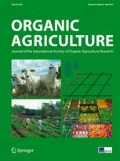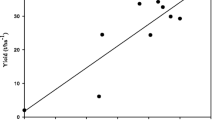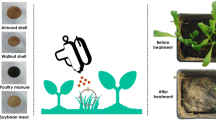Abstract
This study tested the herbicidal effects of raw and processed culinary oils (rapeseed oil, sunflower oil, olive oil, flax/linseed oils) on nine plant species (poppy, white clover, alyssum, lupin, buckwheat, mustard, oats, perennial ryegrass, tall fescue). Oils were also tested on weeds that naturally emerged from farm soil. Plants were coated with oil using a pressurized hand pump, then maintained in a glasshouse or outdoor plant facility until harvested approximately 5 weeks after oil application. All the oils tested caused a decrease in plant dry matter compared with water-sprayed control treatments, although there was some inconsistency in herbicidal effects among plant species, trials and growing conditions. Spraying plants with rapeseed oil on multiple occasions tended not to be more phytotoxic than only a single spraying. Raw or organic oils were not consistently more phytotoxic than processed versions of the same oil type. There was some evidence that negative effects of oils on plant growth were more apparent under warmer conditions. The results suggest that culinary oils could reduce the biomass of weeds in an environmentally friendly way that is permissible to organic growers. However, the herbicidal activity of these oils appears low, and the quantities required to obtain substantial weed control may not be economically viable in all instances.


Similar content being viewed by others
References
Amri I, Hamrouni L, Hanana M, Jamoussi B (2013) Reviews on phytotoxic effects of essential oils and their individual components: news approach for weed management. Int J Appl Biol Pharm Technol 4:96–114
Ascard J (1995) Effects of flame weeding on weed species at different developmental stages. Weed Res 35:397–411
Bond W, Grundy AC (2001) Non-chemical weed management in organic farming systems. Weed Res 41:383–405
Boyd NS, Brennan EB (2006) Burning nettle, common purslane, and rye response to a clove oil herbicide. Weed Technol 20:646–650
Cai X, Gu M (2016) Bioherbicides in organic agriculture. Horticulturae 2:3. https://doi.org/10.3390/horticulturae2020003
Cornish A, Battersby NS, Watkinson RJ (1993) Environmental fate of mineral, vegetable and transesterified vegetable oils. Pestic Sci 37:173–178
Dayan FE, Cantrell CL, Duke SO (2009) Natural products in crop protection. Bioorganic and Medicinal Chemistry 17:4022–4034
Ellis PD (2010) The essential guide to effect sizes: statistical power, meta-analysis, and the interpretation of research results. Cambridge University Press, Cambridge, p 192
Fogelberg F (2009) Possibility of using mustard meal of Sinapsis alba and Brassica juncea for weed control. 8th EWRS Workshop, Zaragoza, Spain. 121–124
Gan-Mor S, Hetzroni A, Elad Y, Ronen B, Mizrach A (2012) Technical note: compact energy-saving emulsifier for on-site production of edible oil-based control agents. Trans ASABE 55:2079–2085
Gauvritz C, Cabanne F (1993) Oils for weed control: uses and mode of action. Pestic Sci 37:147–153
Heini J, Mainx H-G, Gerhards R (2012) Evaluation of the potency of different seed oil ethoxylates to increase herbicide efficacy in comparison to commercial adjuvants. 25th German conference on weed biology and weed control, march 13-15, 2012, Braunschweig, Germany. Julius-Kuhn-Arch 434:549–556
Izadi-Darbandi E, Aliverdi A, Hammami H (2013) Behavior of vegetable oils in relation to their influence on herbicides’ effectiveness. Ind Crop Prod 44:712–717
Kolb LN, Gallandt ER (2012) Weed management in organic cereals: advances and opportunities. Org Agric 2:23–42
Kozak M, Piepho H-P (2018) What's normal anyway? Residual plots are more telling than significance tests when checking ANOVA assumptions. J Agron Crop Sci 204:86–98
Lanini WT (2010) Organic herbicides—do they work? Calif Weed Sci Soc J 6:1–3
Latify S, Yousefi AR, Jamshidi K (2017) Integration of competitive cultivars and living mulch in sunflower (Helianthus annuus L.): a tool for organic weed control. Org Agric 7:419–430
Liebman M, Davis AS (2009) Managing weeds in organic systems: an ecological approach. In: Francis C (ed) Organic farming: the ecological system. Agronomy monograph 54, pp 173–195
McErlich AF, Boydston RA (2013) Current state of weed management in organic and conventional cropping systems. In: Young SL, Pierce FJ (eds) Automation: the future of weed control in cropping systems. Springer, Dordrecht, pp 11–32
Merfield CN (2007) Steam and fish fertilisers: a potential organic systemic herbicide? 7th EWRS workshop on physical and cultural weed control. Salem, Germany, pp 138–142
O’Sullivan J, van Acker R, Grohs R, Riddle R (2015) Improved herbicide efficacy for organically grown vegetables. Org Agric 5:315–322
Onofri A, Carbonell EA, Piepho H-P, Mortimer AM, Cousens RD (2010) Current statistical issues in weed research. Weed Res 50:5–24
Pannacci E, Kopp P, Mathiassen S, Kudsk P (2010) Effect of adjuvants on the rainfastness and performance of tribenuron-methyl on broad-leaved weeds. Weed Biol Manag 10:126–131
Piepho H-P, Willimiams ER, Fleck M (2006) A note on the analysis of designed experiments with complex treatment structure. Hortscience 41:446–452
Popay I, Champion P, James TK (2010) An illustrated guide to common weeds of New Zealand (3rd Ed.). Lincoln, New Zealand: New Zealand Plant Protection Society 448pp
Ramezani S, Saharkiz MJ, Ramezani F, Fotokian MH (2008) Use of essential oils as bioherbicides. J Essent Oil Bearing Plants 11:319–327
Rasmussen J (2003) Punch planting, flame weeding and stale seedbed for weed control in row crops. Weed Res 43:393–403
Saville DJ (2015) Multiple comparison procedures - cutting the Gordian knot. Agron J 107:730–735
Synowiec A, Kalemba D, Drozdeke E, Bocianowski J (2017) Phytotoxic potential of essential oils from temperate climate plants against the germination of selected weeds and crops. J Pest Sci 90:407–419
Turk MA, Tawaha AM (2003) Allelopathic effect of black mustard (Brassica nigra L.) on germination and growth of wild oat (Avena fatua L.) Crop Prot 22:673–677
Tworkoski T (2002) Herbicide effects of essential oils. Weed Sci 50:425–431
Nathan S. Boyd, Eric B. Brennan, (2006) Burning Nettle, Common Purslane, and Rye Response to a Clove Oil Herbicide. Weed Technology 20 (03):646-650
Acknowledgements
The authors wish to thank to Brent Richards and Leona Meachen for help with plant maintenance. The authors have no conflicts of interest to declare. Raw data for all trials is available from the corresponding author.
Author information
Authors and Affiliations
Corresponding author
Appendices
Appendix 1
Appendix 2
Rights and permissions
About this article
Cite this article
Hodge, S., Merfield, C.N., Bluon, A. et al. The potential of culinary vegetable oils as herbicides in organic farming: the effect of oil type and repeated applications on plant growth. Org. Agr. 9, 41–51 (2019). https://doi.org/10.1007/s13165-018-0208-z
Received:
Accepted:
Published:
Issue Date:
DOI: https://doi.org/10.1007/s13165-018-0208-z




